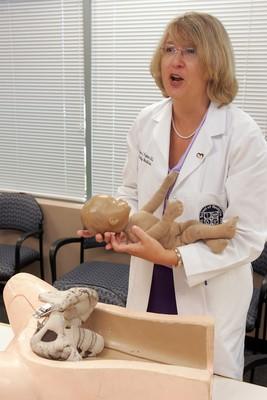Nevada gets more research aid
When it comes to preventing chronic disease or medical complications, Nevada seems to always linger toward the bottom of some annual federal list.
If the University of Nevada School of Medicine has its way, the Silver State will eventually become a mainstay in the middle or the top of these annual state-by-state rankings. In doing their part to turn around those dreary statistics, school of medicine professors and researchers are applying for and receiving more federal and state grants to study methods in preventing chronic diseases, conditions and medical complications in Nevada.
Those include diabetes, obesity, premature births, suicide and osteoporosis.
Though most grants are awarded by the National Institutes of Health, one of the nation's leading medical research dollar gift givers, some are available through the State Trust Fund for Public Health, said Dr. David Lupan, associate dean of the school's basic science research department.
The trust fund grew out of the national tobacco settlement. About 10 percent of Nevada's settlement dollars go into the fund.
So far this year, the medical school has received about $1.1 million in trust fund grants. Numbers for previous years were not available.
By year's end, Lupan anticipates the School of Medicine will have matched or surpassed last year's federal and state grant totals.
Last year, it received just over $17 million in NIH dollars, Lupan said. That number has steadily increased in recent years.
In 2005, the latest year for which figures are available, Nevada's school of medicine ranked 101st out of the nation's 130 medical schools in receiving NIH funding -- about $13 million. Johns Hopkins University, which has one of the nation's largest medical schools, ranked No. 1, receiving just over $449 million.
"We've crept up a bit. I believe we have hit 99. It's a moving target,'' Lupan said. "A large portion of these grants are requested by our teaching staff who happen to be clinicians.''
Lupan said through their patients, these clinicians are able to determine first-hand what the community's needs are.
For example, Nevada's suicide rate is almost double the national average. Suicide is the sixth leading cause of death in the state, and the third leading cause of death among people ages 15 to 24. In 2006, more than 400 Nevadans took their own lives.
Barbara Kohlenberg, a professor in the Department of Psychiatry, and Marta Elliott, a professor in the Department of Sociology, plan to use a $126,000 research grant to study causes of suicide among people age 18 and older in Nevada.
During the study, which begins in July, Kohlenberg and Elliott plan to meet with patients being treated after having survived suicide attempts. The goal is to hear from them about what led to the attempt, Kohlenberg and Elliott said.
Both believe interviewing survivors of near-lethal suicide attempts and comparing them with people whose attempts were unlikely to be fatal will help the medical community improve upon and prevent suicide attempts. By interviewing survivors of near-lethal suicide attempts, and by comparing them with people whose attempts were unlikely to be fatal, Kohlenberg and Elliott hope to learn more about the specific circumstances in which a suicide attempt results in death.
"I want to hear in their own words why people make the decision to take their own life. Through that narrative, we are looking for patterns in stories and the motivations behind the action,'' said Elliott, the lead investigator in the study. "This is a very serious problem that plagues people of all ages.''
Another major medical problem in Nevada is obesity in young adults.
Jeff Angermann, an adjunct clinical faculty member with the School of Medicine, is receiving a $220,000 trust fund grant to study obesity in young adults ages 18 to 24. Angermann plans to measure the prevalence of obese and overweight patients visiting the University's Student Health Center and the medical school's Family Medicine Center to determine if either brief advice from a physician or a trained expert program can help patients lose weight.
According to statistics, 70 percent of men and 49 percent of women nationwide were either overweight or obese in 2004, while in Nevada, 60 percent of the entire population was considered overweight. The highest increases in any obesity age group in the past few years is the 18- to- 24-year-old demographic, health officials say.
Meanwhile, Dr. Elissa Palmer, a professor in the school's department of family and community medicine, is using grant dollars to improve the way Nevada physicians do their jobs.
Palmer's grant, just over $200,000, will establish the Nevada Advanced Life Support For Obstetrics Training Program.
Starting next Spring, Palmer and others will provide Nevada family medicine physicians, OB-GYNs and nurse midwives with a two-day certified training program in which they simulate deliveries and any complications that can occur during the procedure.
"What should happen if they shoulders get stuck or if the mother starts bleeding after she's given birth?'' Palmer said. "What should you do if there is a breech delivery? ... For the most part, this is all common knowledge (for medical care professionals). Everyone just has to do be on the same page. That's what this course is about.''
In applying for the grant, Palmer highlighted Nevada's large number of medical emergencies and complications during deliveries.
She also listed the training program is needed because of the high costs of malpractice insurance, physician shortages in rural areas, distances rural women must travel for maternity care, and increasing minority populations who do not receive timely prenatal care.

















